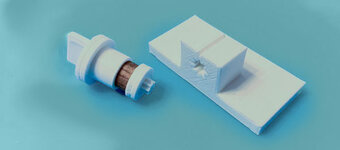Wmcullen
Member
I'm not sure if this process is right or wrong; unique or common. But it works for me and I want to share in case it's interesting. |
The Problem
Every time I drill holes free-hand, the pattern comes out looking haphazard, uneven and sloppy. So I put a jig together to keep the circles lined up properly.
Here's my process
(Not rocket surgery, just how I do it.)
Light wood dowels
1. I thought using round toothpicks would be a good (and thrifty) idea. But I found an equally inexpensive and better option in the craft section of Walmart. These thin dowels cost $1.30 for a 50 pack and fit perfectly into holes drilled with a 3/32" bit.
2. I cut a few pieces of dark wood (morado) about 1/3" thick, drilled 1/4" center holes, and separated them into squares.
Here's where I had some frustration/fun.
Drilling equally spaced holes in a straight line around the band was a challenge. So I built a jig to use in conjunction with a drill press.
This jig ensures all holes are drilled on the same line around the band's circumference and at 45 degree increments.
I'm sharing my 3d print file in case it's helpful to anyone.
But I'm not that confident in my setup and worry the bit will travel off course.
Drilling to the center also keeps any tear-out on the inside.
Each thin dowel is 6" long and has plenty of material for the band.
Sharp scissors cut through the dowel easily and keep the end unbroken and usable.
I push the dowels all the way through assuming I will need to re-drill the 1/4" center hole.
(Maybe I should put the center bands on an old mandrel before this step for easier re-drilling?? Hmmmm.)
I'm sure there are better/simpler jigs to accomplish this. Or people are just been more careful while drilling. But this process works for me and it was, frankly, fun to put together.
Incorporating dowels into pen designs can be a great way to introduce unique elements found only in your pens.
Jig Breakdown
- Glue Parts A&B together.
- Glue Parts C&D together.
This sliding piece is kept intentionally loose to move where it's needed.

